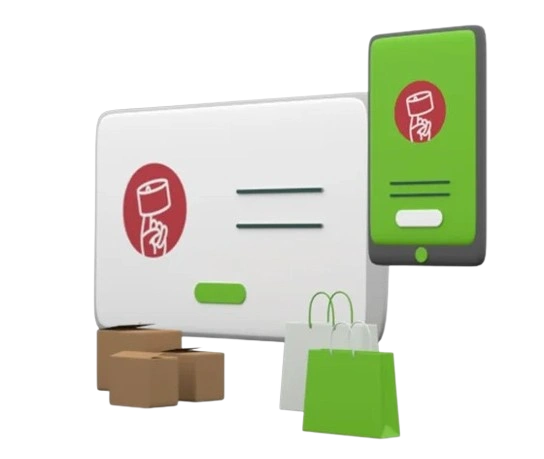Top 7 E-commerce Order Management Software for Online Businesses
One bad order experience can turn a customer away for good. Imagine spending thousands on ads, only to lose hard-earned trust due to delayed or messy fulfillment. Poor order management is the silent killer of e-commerce—and it often strikes when you least expect it.
Online businesses are growing rapidly, and with this growth comes the challenge of efficiently tracking inventory across multiple sales channels, handling returns properly and maintaining real-time synchronization of stock levels. As brands scale, these cracks widen unless supported by robust e-commerce order management software.
This blog presents the 7 most effective e-commerce order management systems, built to help you thrive. Whether you're a startup or a scaled enterprise, these tools are the backbone of smarter fulfillment, cleaner inventory tracking, and bulletproof customer experiences.

Power your growth with Ginesys’ smarter order management software.
What is an Order Management System (OMS)?
An Order Management System is typically a specialized software solution that centralizes, automates, and optimizes all the phases of the order lifecycle. Think of it as mission control for your online sales ecosystem.
The major functions of a marketplace inventory management software include:
- Order Capture: Aggregates orders from all sales channels, e.g., websites, marketplaces, and retail POS.
- Order Routing: Routes each order to the best fulfillment location according to rules and inventory.
- Inventory Synchronization: Instantly updates product availability across all platforms in real time.
- Fulfillment Management: Coordinates the processes of picking, packing, and shipping.
- Returns and Refunds: Automates reverse logistics and provides notifications to customers.
- Analytics and Reporting: Surfaces insights on order velocity, fulfillment time, and stock levels.
But is it mission-critical? Customer happiness hinges on speed, accuracy, and clear updates. If your e-commerce inventory and order tools can’t keep pace or link smoothly across platforms, delays multiply, mistakes escalate, and loyalty erodes.
Consider this scenario: You sell on Amazon, your website, and a retail store. An item is in stock on your site, but someone bought the last one in-store. Without real-time marketplace inventory management software, customers can buy items that are already out of stock — leading to frustration and lost trust. Cue the refund, the negative review, and the lost lifetime value.
So, without solid online order tools that direct all these moving parts, you are flying a plane with no dashboard.

Power your brand with flawless order fulfillment today.
How to Choose the Right OMS?
Now picture a typical day. You’ve just launched your product on three fresh marketplaces, and orders are booming—but customer complaints about backorders are piling up. Your staff jumps between spreadsheets, aging emails, and isolated software, trying to piece together the story for each customer. Does that ring a bell?
This is where the right e-commerce order management system transforms chaos into coordination. However, not all solutions are created equal. As you weigh options in 2025, here are the must-have features to invest in:
- Omnichannel Order Sync: Modern consumers don’t care where your backend systems are; they simply expect a smooth, joined-up journey. A sound order management system needs to pull together sales from Shopify, Amazon, Meesho, Flipkart, Myntra, Ajio, TataCliq, Jiomart and more stores, all in the same heartbeat. According to Forrester, businesses leveraging advanced e-commerce order management software with omnichannel synchronization capabilities experience up to 30% faster order cycle times.
- Real-Time Inventory Visibility: Nothing eats into profit like overselling. With demand spikes driven by flash sales and influencer collaborations, the OMS must provide instant SKU-level updates across every warehouse, fulfillment center, and drop-shipper. Top inventory tools then steer smart allocations, trigger speedy reorders, and alert customers before shelves run dry, saving refunds and damage to brand trust.
- Marketplace and ERP Integrations: Separate platforms create blind spots and mistakes no one notices until a shipment fails. Choose an e-commerce order system that talks out of the box to ERP, CRM, WMS, and 3PLs so data flows naturally. This e-commerce marketplace integration software reduces data silos and lets teams operate from a single source of truth. More integrations also mean faster onboarding for new channels and better data governance—two must haves for growing e-commerce firms.
- Automation and Rules-Based Routing: When order volumes soar, picking and processing them by hand quickly slows everything down. An advanced e-commerce OMS software should offer workflow builders that allow retailers to create intelligent rules. For example, automatically routing North India orders to the Delhi fulfillment center, flagging high-value transactions for review, or splitting international orders by fulfillment partner. This type of automation boosts efficiency and reduces human error and fulfillment costs.
- Scalability and Cloud-Readiness: The order management system shouldn’t be the bottleneck to growth. A truly scalable, cloud-based OMS can flex during peak seasons, sales events, or international expansions without downtime. Look for platforms that guarantee 99.9% uptime SLAs and offer microservices-based architecture. These e-commerce OMS platforms support thousands of transactions per minute and give global access and real-time insights—on any device, anywhere.
Checklist for Evaluating an OMS
- Supports Multichannel E-commerce Order Management: Ensure the OMS can seamlessly handle orders from webstore, marketplaces, retail stores, and social commerce channels—all in one unified view.
- Offers Real-time Inventory Management Software for E-commerce: Look for accurate livestock updates across warehouses, stores, and channels to prevent overselling and stockouts.
- Provides Pre-built ERP, CRM, and WMS Integrations: A strong OMS that plugs effortlessly into the existing tech stack, syncing data across systems to avoid manual errors and delays.
- Enables Automation through Workflows or APIs: Tools such as smart routing, auto-splitting, and open API connections reduce grind work and friction across the team.
- Includes Reporting and Analytics Tools: Clear dashboards and on-the-spot insights to watch key metrics, spot slow points, and tweak processes before problems accelerate.
- Transparent Pricing with No Hidden Fees: Rates should be simple, predictable, and scale with volume—so there are no surprises as your order volume grows.

The Top 7 E-commerce Order Management Software
Picking the right system can lift or sink your online store. To help you stay ahead, here’s a curated list of the top 7 best e-commerce order-management solutions that smooth fulfillment, sharpen efficiency, and grow your brand.
1. Ginesys OMS + Ginesys One
Ginesys OMS is an integrated marketplace inventory management software crafted for India’s omnichannel stores with ERP, POS, and stock control order/inventory management all under one roof. Here are some of the key capabilities of Ginesys OMS and Ginesys One:
- Dynamic Order Allocation: Automatically routes orders to the nearest store or fulfillment hub based on what is in stock and how quickly the delivery is promised.
- Full Marketplace Integrations: Keeps inventory and pricing matched in real time on Amazon, Flipkart, Myntra, Meesho, and more than sixty other digital storefronts.
- Omnichannel Visibility: A single dashboard shows stock, orders, returns, and both online and in-store sales, so teams can act on data, not guesswork.
- POS Integration via Zwing/Ginesys POS: Links in-store sales and stock levels to the online engine, clearing up blind spots in fulfillment.
- Scalable and Modular: Firms can plug in ERP, OMS, GST, or POS independently, making growth affordable and painless.
- Trusted Reliability: Adopted by over 1,200 brands for full-scale e-commerce order management system needs across India.
- Best For: Retailers needing precise online stock and order handling that works hand-in-hand with back-office ERP and store systems.

Make every order count—upgrade your OMS with Ginesys now
2. Unicommerce
A heavyweight in multichannel e-commerce order management, Unicommerce helps larger brands untangle difficult workflows and keep every sales channel on the same page. Here are some of its key highlights:
- Automated Order Workflows: This enables the system to grab an order, slot the item, pick, pack, and ship with very little human touch.
- Real-time Inventory: Keeps stock counts in the same rhythm across every site so overselling and gaps never happen.
- Warehouse Intelligence: Uses proximity-based logic to route each job to the closest pick up area, saving fuel and time.
- Robust Analytics: Tracks SKUs, turnover speed, return trends, and shipping bills so teams spot trouble fast.
- Best For: High-volume sellers who need a scalable e-commerce order system that blends smart automation with clear reports.
3. Fynd OMS
This multichannel inventory management software excels at intelligent orchestration and delivery optimization. Here are some of the core strengths of Fynd OMS:
- Order Lifecycle Visibility: Tracks order creation, fulfillment status, manifesting, and returns via centralized control.
- Smart Routing Engine: Dynamically assigns fulfillment centers or stores based on zones, SLAs, or stock proximity.
- Automated Carrier Integration: Creates shipping labels and handles multiple courier options efficiently.
- Delivery Promise Calculation: Clear, accurate ETA shared with customers upon purchase.
- Return Management and Analytics: Simplified return logging, label generation, and instant dashboards.
- Ease of Use: High user satisfaction, praised for fast issue resolution and clean UI.
- Best For: Brands aiming for seamless, rule-based order fulfillment across channels with minimal manual setup.

Scale confidently with an order system built for growth.
4. EasyEcom
An e-commerce operating system offering full-stack e-commerce inventory sync and order management merged with accounting, warehouse, and payment reconciliation. Here are some of the in-depth capabilities of EasyEcom:
- Unified Omnichannel Dashboard: Handles orders, inventory, shipments, payments, returns, and accounting in one place.
- Scale-enabling Architecture: Processes over 1.6 billion orders, integrates 9,000+ brands and 235+ platforms across 45+ countries.
- Warehouse and Vendor Modules: Covers procurement, GRNs, bin-level picking, advanced cycle counts, and barcode scanning.
- Accounting Integration: Direct sync with Tally, SAP, or in-built ledger; simplifies reconciliation and compliance tasks.
- Intelligent Finance Controls: Prevents stock leakage and supports fraud detection through Android handheld terminals.
- Security and Compliance: ISO 27001, GDPR, SOC, VAPT, and Amazon certified—ideal for enterprise-level risk control.
- Best For: Businesses needing end-to-end e-commerce OMS software that ties inventory to finance and ops with enterprise-grade structure.
5. Zoho Inventory
A versatile inventory management software for e-commerce that combines multichannel fulfillment, warehouse control, and order intelligence. Here are some of the feature sets of Zoho Inventory:
- Multi‑warehouse Support with inter-location transfers, drop shipping, and picklist generation.
- Serial and Batch-level Tracking for traceable stock management, critical for expiry-sensitive or serialized products.
- Channel Sync with marketplaces (Amazon, eBay, Etsy), carts (Shopify, WooCommerce), and FBA support.
- Robust Shipping Automation: Integrates ~30 carriers for live rates, label printing, and tracking updates: a strong online order management tool feature.
- Smart Automation: Alerts, webhooks, custom functions for workflows—late-fee triggers, reorder automation.
- Mobile Apps and Support: iOS/Android apps plus 24×5 global support ensure uninterrupted operations.
- Best For: Sellers requiring strong marketplace inventory management software capabilities along with granular inventory tracking and shipment coordination.

Streamline orders the smart way—book your Ginesys demo
6. Orderhive
This multichannel inventory management software is a flexible, pay‑as‑you‑go online order management tool, now part of Cin7’s ecosystem—ideal for growing retailers. Here are some of the platform highlights:
- Channel Integrations: Syncs Amazon, eBay, Shopify, Etsy, WooCommerce, plus Xero/QuickBooks.
- Automation Engine: Custom triggers for order status, invoicing, and shipment—tailored workflows to remove repetitive tasks.
- Shipping Support: Compare rates, print labels, notify customers, and manage carriers within the system.
- Inventory and Order Sync: Real-time stock updates across channels; barcode-driven pick/pack enhances accuracy.
- Analytical Insights: The dashboard reflects order volume, shipping times, stock movements, and low-stock alerts.
- Pricing Transparency: Starts at ~$50/month—scales with your business without heavy contracts.
- Best For: Budget-conscious SMEs seeking robust e-commerce OMS software under flexible pricing.
7. Inciflo
Enterprise-grade e-commerce order management system providing deeper integration with supply chain and WMS needs. Here are some of the enterprise features of Inciflo:
- Comprehensive OMS and WMS: Includes order lifecycle, fulfillment, POs, returns, mobile scanning and marketplace inventory management software.
- Real‑time Accuracy: AI-led inventory updates and order status ensure sub-accuracy across the network.
- Supply Chain Oversight: A unified dashboard provides visibility into warehouse workflows, bottlenecks, and operations.
- Widespread Compatibility: Integrates with ERP/accounting tools and connects to warehouse automation stacks.
- User-friendly and Cost-effective: Praised for ease of use, customizability, and ROI – with top-tier ratings on service & management.
- Best For: Large enterprises and high-volume D2C brands aiming for an integrated e-commerce OMS platform tied to complex WMS and supply chain flows.

Why Ginesys Stands Out in This List
Here’s where Ginesys makes an extraordinary leap. While most e-commerce order management system providers retrofit global-first tools for India, Ginesys was built India-first. What does that mean in the real world?
- GST-native and Marketplace-synced: Ginesys understands Indian compliance like no other. Its e-commerce order management software is built to handle India’s GST complexity and syncs directly with leading marketplaces like Amazon, Flipkart, and Ajio.
- Truly Unified Suite: ERP, POS, OMS, and WMS in one integrated solution. No silos, no spaghetti tech stacks. That’s rare in the world of e-commerce inventory and order management.
- Zwing Integration: For omnichannel retailers bridging online and offline, Ginesys + Zwing creates a seamless ecosystem. Whether your customer buys in-store or online, the experience is unified, consistent, and efficient.
- Used by India’s Top Brands: Ginesys is trusted and battle-tested by India’s leading retail brands. For businesses seeking scalable online marketplace integration software, that kind of credibility makes all the difference.
- Built to Scale for D2C, B2B, and Omnichannel: Whether you're a startup riding a D2C wave or an established player managing complex B2B workflows, Ginesys scales with you. That’s why it’s considered among the best order management software for e-commerce in India.

Master multichannel retail and reimagine fulfillment with Ginesys
Key Takeaways
To wrap things up, here’s a quick recap of what to look for in a future-ready e-commerce OMS—built to scale, streamline, and empower at every stage of your order lifecycle.
- Prioritize Flexibility and Scale
- Choose an order management software or e-commerce OMS platform that handles not just today’s volume, but tomorrow’s.
- Look for e-commerce inventory sync and order management features that span warehouse, storefront, marketplace—even offline channels—anticipating your next move.
- Seek True Omnichannel Visibility
- Top-rated online order management tools and best order management software for e-commerce aren’t just dashboards—they’re live, two-way nerve centers tying multichannel e-commerce order management into one pulse.
- Systems like Ginesys OMS offer real-time stock adjustments across POS, marketplaces, webstores, and warehouses—minimizing out-of-stock and double-selling.
- Demand Built-in Intelligence and Automation
- The best e-commerce order management software should include smart order splitting, AI-based ETA predictions, and automated accounting reconciliation.
- Ginesys OMS (Browntape) auto‑allocates orders to optimal fulfillment centers, automates shipping labels, and syncs marketplace finances straight into ERP.
- With transparency and actionable insight built in, you gain tighter inventory control and faster turnaround—earning loyalty and higher NPS.
As a closing note, here’s how to match the right OMS to your business stage and growth goals:
- Small/mid‑sized Brands focused on India or regional expansion: lean into an e-commerce OMS platform that offers multichannel e-commerce order management with a straightforward setup—Ginesys tops here.
- Larger Retailers or those scaling internationally: prioritize order management software for e-commerce that integrates with ERP, WMS, and POS, supports high‑volume SKUs, and spans geographies.
- Marketplaces + D2C Businesses: require e-commerce order management software with robust marketplace connectors, inventory management software, and real-time reconciliation.
Future-ready retail requires future-ready tools. Investing in the best order management software for e-commerce is a competitive advantage. It transforms chaotic sales flows into seamless experiences and data into action.
That’s where Ginesys OMS stands out. Built for both scaling brands and established retailers, Ginesys offers an end-to-end order management platform tailored for India-first commerce.
Ready to transform your order fulfillment experience? Book a Ginesys demo today and unlock seamless commerce with Ginesys.

